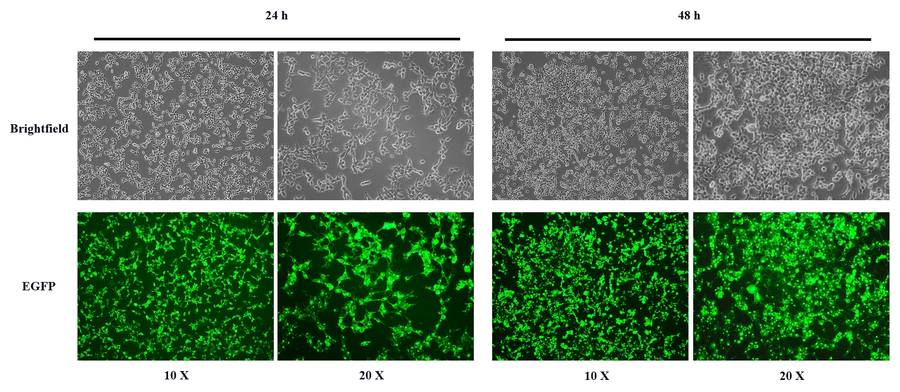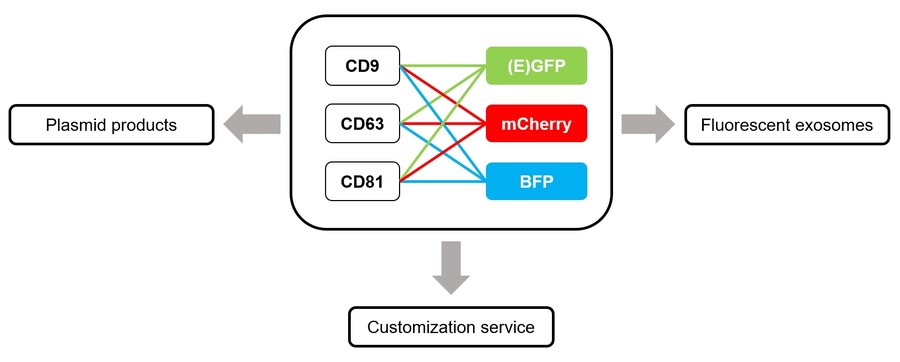Virus mediated Exosome Labeling Service
Overview Services Features FAQs
Overview
Wide Range of Viral Vectors for Exosome Labeling
Exosomes are extracellular vesicles released when multivesicular bodies within the cell fuse with the cellular membrane. Through genetic engineering of parental cells, the exosome membrane can be modified according to the mechanism of exosome generation. Fluorescent proteins are commonly used as reporter proteins, which emit a fluorescent signal when excited by light of a specific wavelength. By infecting parental cells with viral vectors carrying sequences for both fluorescent proteins and exosomal membrane proteins, these cells can be genetically modified to secrete exosomes that contain fluorescent proteins. This enables the tracking of exosomes as they move from donor to recipient cells.
Services
Creative Biolabs offers a variety of viral vectors that can be used to infect parental cells directly, assisting customers in tracking exosome movement.
Extensive Selection of Viral Vectors for Exosome Labeling
Replication-defective recombinant viruses, such as lentiviruses with deleted virulence-related genes, are widely used in genetic engineering. These viruses can efficiently introduce and integrate exogenous genes into the genome of target cells through in vitro infection, ensuring long-term expression of the genes in both dividing and non-dividing cells. Lentiviruses have the ability to infect a broad range of host cells, including tumor cell lines, fibroblasts, neurons, lymphocytes, and macrophages. The tetraspanin family proteins, such as CD63, CD81, and CD9, are highly expressed on exosomal membranes and are involved in exosome trafficking. By incorporating these exosomal membrane proteins along with fluorescent proteins into lentiviral vectors, the vectors can be used to infect parental cells. The fluorescent membrane proteins expressed on the exosome membrane can then be utilized to track the formation, secretion, targeting, and trafficking mechanisms of exosomes.
 Fig.1 Images of HEK293T cells transfected with the CD63-EGFP plasmid at 24- and 48-hours post-transfection.
Fig.1 Images of HEK293T cells transfected with the CD63-EGFP plasmid at 24- and 48-hours post-transfection.
 Fig.2 EGFP-labeled exosome identification by transmission electron microscopy (A), nanoparticle tracking analysis (B), and nano-flow cytometry (C).
Fig.2 EGFP-labeled exosome identification by transmission electron microscopy (A), nanoparticle tracking analysis (B), and nano-flow cytometry (C).
Features
-
The lentiviral vectors developed by Creative Biolabs can express fusion proteins through the CMV promoter in most mammalian cells.
-
These lentiviral vectors have high biological safety, a wide range of hosts, and high lentiviral titers, which can reach 10^9 TU/mL.
-
Creative Biolabs provides lentiviral vectors and purified fluorescent exosomes carrying different fluorescent markers (including (E)GFP, BFP, and mCherry), which can meet customers' requirements for color.
-
If you have innovative ideas and needs, Creative Biolabs can provide you with personalized fluorescent exosome preparation services.
 Fig.3 Fusion strategy of exosomal membrane proteins and fluorescent proteins.
Fig.3 Fusion strategy of exosomal membrane proteins and fluorescent proteins.
Creative Biolabs is the leading provider of exosome services and products. We can provide one-stop services including exosome extraction, exosome identification, exosome modification, exosome profiling, and exosome function verification in vivo and in vitro. Please contact us to put forward your needs and ideas to provide you with the most suitable products, or formulate the most suitable solutions.
FAQs
Q: How does our service assist in exosome tracing research?
A: Our service can construct fusion proteins by combining exosome surface marker proteins with fluorescent proteins, enabling the donor cells to release exosomes with inherent fluorescence. This allows researchers to easily track the dynamic distribution of these exosomes both in vivo and in vitro.
Q: What are the advantages of using virus-mediated exosome labeling?
A: With exosomes inherently carrying fluorescence, researchers can observe the distribution and migration of exosomes in real-time, reducing the need for additional labeling steps and enhancing the accuracy and efficiency of experiments. Moreover, this method minimizes potential interference from external dyes on exosome function.
Q: How can the fluorescent signal of exosomes be detected in experiments?
A: The fluorescent signal of exosomes can be detected through various methods, including fluorescence microscopy, flow cytometry, and live imaging systems. We recommend selecting the appropriate detection method based on the specific requirements of your experiment.
For Research Use Only. Cannot be used by patients.
Related Services:

 Fig.1 Images of HEK293T cells transfected with the CD63-EGFP plasmid at 24- and 48-hours post-transfection.
Fig.1 Images of HEK293T cells transfected with the CD63-EGFP plasmid at 24- and 48-hours post-transfection.
 Fig.2 EGFP-labeled exosome identification by transmission electron microscopy (A), nanoparticle tracking analysis (B), and nano-flow cytometry (C).
Fig.2 EGFP-labeled exosome identification by transmission electron microscopy (A), nanoparticle tracking analysis (B), and nano-flow cytometry (C).
 Fig.3 Fusion strategy of exosomal membrane proteins and fluorescent proteins.
Fig.3 Fusion strategy of exosomal membrane proteins and fluorescent proteins.









